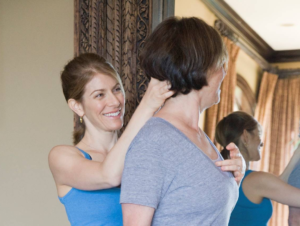
Receiving a breast cancer diagnosis and coming to terms with all that goes along with it can be a traumatic process for the patient. Interpreting pathology reports, processing treatment options and waiting for doctors appointments can trigger an intense stress response in the patient’s body.
Furthermore, surgery can bring more than just physical scar tissue. The adjustments to one’s life post-operation can be incredibly challenging. Self-consciousness about appearance and fear of pain during movement are often just the tip of the somato-emotional iceberg.
When my mom was diagnosed with breast cancer in 2003 I felt helpless, and so did she. It wasn’t until much later, when I was introduced to the self-care practices in Yoga Tune Up®, that I began to realize that she could be empowered to help herself feel better. This work has been transformative for her, even though she wasn’t introduced to it until over a decade after her diagnosis. It continues to be of positive benefit for the many patients with breast cancer with whom it has been shared.
The information below is intended to help you feel less like a deer-in-the-headlights and more informed when a client discloses their breast cancer diagnosis to you.
My intention is that for YTU instructors or caretakers working with clients with breast cancer, this article (and the one that follows outlining common treatments and self-massage and movement practices to support healing) may offer a thoughtful place to start. However, as with any client be sure to obtain medical clearance for the modalities you intend to utilize. (christophechoo.com)
Working With the Emotions of Breast Cancer

Going through breast cancer treatment is fatiguing. With this diagnosis, there might be a hearty amount of physical and emotional trauma for your client to work through. The best way you can support your client is to be as informed, compassionate and resourceful as possible.
Being the caretaker can be a taxing role. It is crucial that you maintain your personal and professional boundaries and do not absorb the stress and sadness that a client may release in your presence. Most clients appreciate the sense of safety they get from a gentle and calming demeanor. Your compassion is usually appreciated, but your personal emotions may not be.
Effectively working with breast cancer patients will require that you are able hold space for authenticity. This means be present, and have your own Sankalpa intact. A Sankalpa is like a personal “mantra” – it’s a chosen internal resolution or mindset that helps to positively reshape and influence one’s direction and purpose (definition from the Yoga Tune Up® Level 1 Teacher Training manual).
When working with breast cancer patients, I will often choose a Sankalpa that’s simple and clear like: I create a safe space for healing.
A Sound Place to Start
A biopsy marks the beginning of almost every woman’s breast cancer journey. A breast biopsy is a test that removes tissue or fluid from the suspicious area and tests it for breast cancer. The tissue trauma from the procedure is typically minimal, but the emotional stress can be significant. This is an excellent time for your student to enhance her proprioceptive relationship to her body through self-soothing therapy ball work.
I suggest what is referred to in The Roll Model book as a ‘Freestyle Exploration’ of the Front, Back and Side Seams of the body using therapy balls. The ‘seams’ are continuous lines of fascia that connect seemingly distant body parts. “Working on one ‘seam’ will truly help you feel the interconnectedness of the fascias associated with that aspect of your body… Take each of these different ‘seams’ through progressive detangling, and feel the ease in your range of motion and pain reduction change after you roll.” (The Roll Model, P. 350).
Another aspect of helping a person with breast cancer is figuring out what not to do. There are many side-effects that we are powerless to help with, but meeting your client where they are requires knowing how they feel.
For instance, Lymphedema is a potential side effect of several breast cancer treatments. It comes with many possible complications and contraindications.
The lymphatic system is an important network of nodes and vessels that carry lymphatic fluid (lymph) from the tissues of the body toward the heart. Surgery and radiation can cut off or damage some of these tissues. Over time, the flow of lymph can overwhelm the remaining pathways, eventually resulting in an accumulation of fluid in local tissues (edema).
Lymphedema can appear during the months or even years after treatment ends. It usually occurs in the arm and hand. But sometimes it affects the breast, underarm, chest, trunk and/or back.
Regarding prevention and management of lymphedema, there’s a good deal of conflicting advice out there. For self-massage and movement teachers, most therapy ball work would be contraindicated here, and exercises need to be specifically structured to meet the client’s fluctuating needs. My advice, unless you happen to be an experienced lymphedema therapist, is to employ non-invasive techniques like breath practices that calm the nervous system such as abdominal breathing or sustained exhales.
Every human is different, as is every cancer diagnosis and every course of treatment. Once you know your client personally, you can then get to know those condition-specific contraindications as well.
When in Doubt, Keep it Simple
For some clients, just creating a comprehensive Sankalpa and working to find the physiological space in which to embrace it is a significant feat. If you find your client is receptive, your first sessions can be devoted solely to that process. Understanding the basics of their body’s natural stress responses and having this simple mindset strategy to turn on the off-switch can be very empowering.
I also recommend you have an updated list of qualified professionals to refer out to.
Finally, be affordable. During treatment or due to disability afterwards, your clients may be unable to work. One of the biggest frustrations breast cancer patients reported to me was the inability to afford the very services they were being told could help them feel better.
If you don’t have the means to volunteer your time, finding sponsorship can provide creative solutions so you can still offer affordable services to those in need. Find donors to cover the expenses of your workshops and sessions so that these clients can come at no-cost or a discounted rate can be doubly life-changing for them.
Understanding the Physiology of Breast Cancer
Following this article I will be sharing another post outlining the specific treatments for breast cancer. Please tune in next week to learn those physiological details, along with specific self-massage and movement practices to support health and healing.












This is such a valuable article. I especially appreciate the advise about keeping your sankapla close. When my husband was going through chemotherapy during the pandemic, being the caretaker while also being emotionally wrapped up in what was happening was so hard. Often, the person being cared for is the person who would have been caring for the caretaker if they were able. I didn’t realize that it was a sankalpa at the time, but looking back I told myself so many times a day ” I am present with what is here in front of me, and I can help.” It was the safety rope that got me through the year.
This was super informative. I appreciate having a tiny window into working with these patients. You also give us, and them, the permission to slow down to take the time to be with whatever shows up each day.
Thank you for this tremendous resource. I visited the blog this evening seeking advice on roll outs for a student who underwent a double mastectomy, and read all 4 of Riannon’s articles on the topic of breast cancer. Thank you for shifting my focus purely from tissues and mobility to sankalpa. This is sage sentiment and exactly what I didn’t know I was looking for.
To continue with abdominal breathing and lymphedema, it is actually helpful for the lymphatic system to practice abdominal breathing due to the high number of lymph nodes there including the cisterna chyli which is like the descending aorta of lymphatic system.
Thank you so much for this blog. I work with many clients with cancer and your tips are great starting points to help. I especially appreciated the caution about direct rolling of lymphedema. I do think it is important to find ways to make myofascial release and Yoga Tune Up programs accessible to populations who may not have the funds to pay for private instruction outright, as these self-care strategies can be so helpful on physical, mental and emotional levels of well-being. Have you found that group work has been helpful for this population? Or fundraising to provide free private sessions for those in need? I also like how you talk about intention and sankalpa along with deep breathing as the “go to” tools when physical, mental or emotional limitations during the course of a disease might inhibit other interventions – this is such a great reminder! I frequently forget how important it is to have my OWN sankalpa as I approach my clients to guide our work together and hone my own energy – so I appreciated that reminder too 🙂
This is a wonderful blog. Thank you for sharing your knowledge. I’m weeks away from becoming a lymphedema specialist and I will be working with more more breast cancer patients. The sankalpa you use is so spot on and I will definitely be borrowing it!
Great information and truly appreciate the addition of offering your time as cancer community service.
“The best way you can support your client is to be as informed, compassionate and resourceful as possible….I will often choose a Sankalpa that’s simple and clear like: I create a safe space for healing.” Thank you for offering a supportive and informed article for both teachers and clients. I especially like the Sankalpa you offered. Holding space in a compassionate way is so significant.
I was interested in this article because just one of my students has just been diagnosed with breast cancer, and although it has a very good prognosis because it was detected very early, it has been under a lot of stress with all the series of medical studies that it has required and the visit one and another doctor together waiting for the operation and the result of it. And now I know that the best way I can support her is by being empathetic and compassionate but not absorbing her sadness, and by providing her with a safe space to practice and recommending the Sankalpa that Riannon recommends: “I create a safe space to heal,” that can help you be in a positive state and influence your healing!
Thanks for writing this, Rhiannon. Honestly, I have been nervous about teaching group and private classes to those with breast cancer and other cancers, because I didn’t really feel like I had enough specific knowledge on their condition to be of service. Now, I feel like teaching breathing techniques for calming down the nervous system is a great place to start, plant a seed, and create meaningful impact that people with cancer can use in their day to day life. I feel more helpful and capable just reading your words. Thank you so much!!! <3
Thank you for this article and the advice. Self compassion and self care have been critical to me and my mom as she navigated her breast cancer diagnosis this year. She credits her exercise and yoga practice for creating a foundation of physical and emotional health, and I’ve been helping her try YTU and Roll Model techniques to add to her tool box. The sankalpa reminders are key for me as I hold space for her and for her as she practices and navigates the emotional ramifications of such a traumatic diagnosis.
Thank you for all your work to help teachers understand how to “hold the space” for someone going through a healing journey. I also appreciate your point about when certain types of work might be contraindicated. very useful! thank you!
Your article is very mindful and empathetic, thanks for sharing your experience and knowledge about how to work with people who are going through this journey. I’ll keep reading to see the suggested self massage techniques.
This series has sparked so many ideas in me to further my practice with patients with a cancer diagnosis; hosting a seminar for patients and their families, get into the hospital and do some education on mindset, the opportunities for this work are so exponential! Creating material for this will be so fun and has got me excited to do some soul-provoking, physiotherapy/YTU combo to better my program!
this was a touching and wonderful reminder of several students of mine in london who had cancer. i held a weekly group session for them and having this supportive community post surgery was crucial. they didn’t have to feel self conscious about their bodies and the session could be very slow and simple with a lot of breath work. i will use the therapy balls if i have a student with this diagnosis – it’s brilliant and i can only imagine how good it would feel for them. thank you for the suggestion to set a sankalpa and to also manage my emotions for them.
This was a great blog post. I love how you touched on many aspects of recovering from breast cancer. I am looking forward to integrating your tips into my treatments with patients.
Great advice, I found the introduction of the special sankalpa fantastic. Not only for the practice of yoga but also in every conversation that we keep with friends
Thank you for this article and the other detailing the the different treatments. I have two family members who have had breast cancer and two different treatments! It’s great that you remind us to use Sankalpa in these situations and introduce the client to this also. I love that you point out the interconnectedness of the fascias and working with the balls can ‘detangle’ to aid range of motion.
Great advice – for the novice and for the seasoned oncology worker. I have found lymphedema massage to be highly effective. Thank you for speaking to the emotional side and the role of a caretaker.
I was recently asked to do private yoga sessions with one of my regular students after she was diagnosed with breast cancer. We worked together leading up to her surgery and then about a month after she scheduled more sessions. She was in more emotional pain than physical pain and decided to go through the whole experience without telling anyone aside from her husband and closest friends. I suggested we use some YTU balls in her private sessions and the results were astounding. She was so grateful for the ability to feel a “good pain” and let herself have a good cry after every session. Thanks for sharing this post – it shed light on additional issues she may be going through on top of what she told me.
I have always found it challenging to attempt to help clients who have serious illnesses, so I appreciate you reinforcing what I have found to be true about providing a compassionate place for them to experience the intense emotions.
Thank you
Thank you for posting this article, I found it very informative.I deal with cancer patients a lot and I help them choose their sankalpa, but I forget about my own. Thank you for the reminder.
Thank you for this Riannon, i have clients with cancer and take the time to listen, but your article helped me to stay focus. The price of service as well, something lots of in service does not think about. Looking forward to your next article.
This article touched me. My mother was also diagnosed with breast cancer a few years ago and I felt it was very hard to know how to help her. I feel just offering her a space to feel healthy and to be loved helped her tremendously. I know not everyone has that same experience so knowing that you can offer a sankalpa to help someone during this hard time can truly be a miracle. Thank you for sharing your advice and words on this extremely important topic.
Thank you Riannon for your post. In the past several years, I’ve lost too many of my loved ones due to cancer & I’m taking this more seriously than ever, realizing it can happen to anyone, at anytime. This article helped me prepare myself better.